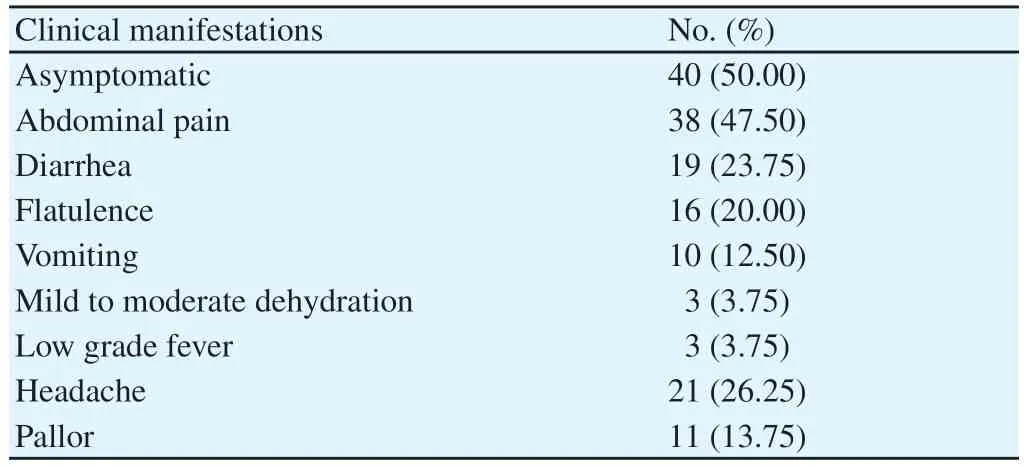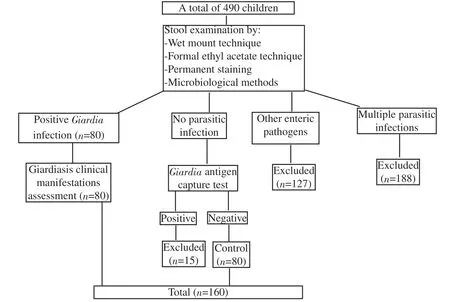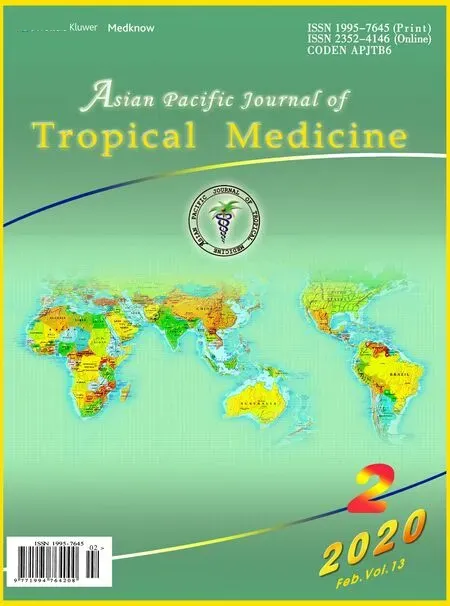Human leukocyte antigen class-Ⅱ DRB1 alleles and Giardia lamblia infection in children: A case-control study
Samar N.El-Beshbishi, Ayat A.ElBlihy, Raefa A.Atia, Ahmed Megahed, Fatma A.Auf
1Department of Medical Parasitology, Faculty of Medicine, Mansoura University, Mansoura 35516, Egypt
2Pediatric Gastroenterology and Hepatology Unit, Mansoura University Children's Hospital, Faculty of Medicine, Mansoura University, Mansoura 35516, Egypt
3Department of Clinical Pathology, Faculty of Medicine, Mansoura University, Mansoura 35516, Egypt
ABSTRACT
KEYWORDS: Giardia lamblia; Giardiasis; Human leukocyte antigen; HLA class-Ⅱ DRB1 alleles; Children
1.Introduction
Giardia (G.) lamblia is one of the most prevalent intestinal protozoa that infects humans worldwide, causing the disease giardiasis[1,2].In Egypt, the estimated prevalence of giardiasis is 18%-48%[3,4].The clinical features of G.lamblia infection vary from asymptomatic infection in about half of cases mainly in resource-poor settings,to loss of appetite, nausea, vomiting, abdominal pain, flatulence,diarrhea, dehydration and severe malabsorption syndrome[5].
The host defenses to eradicate Giardia infection are mediated through a synergism between both innate and adaptive immunity,but the exact defense mechanisms are still poorly understood[6].CD4+T cells have been identified to play a major role in control of Giardia infection, while the effector mechanisms involved in parasite elimination are obscure[7].
It is worth mentioning that the existence or absence of a specific human leukocyte antigen (HLA) class-Ⅱ allele and HLA polymorphism play a crucial role in individual variations in susceptibility and clinical variability of some parasitic diseases[8-11].The role of HLA class-Ⅱgenes responsible for proper antigen recognition and presentation to CD4+T cells in G.lamblia infection has not yet evaluated in human.Hence, this study was conducted to reveal the influence of HLA-DRB1 alleles on the susceptibility or resistance to G.lamblia infection in children.
2.Materials and methods
2.1.Ethical approval and informed consent
The study was approved by the Mansoura Faculty of Medicine Institutional Research Board (No.#R/17.04.100), and was conducted according to the human experimentation ethical guidelines of the Institution Medical Research Ethics committee and the Helsinki Declaration (as revised in 2000).Written informed consent was obtained from parents or legal guardians of the recruited children after explaining the aim of the study.All data of the enrolled children were kept strictly confidential.Patients were referred to a gastroenterologist for treatment of diarrhea and giardiasis.
2.2.Participants
A case control was conducted on a total of 490 Egyptian children aged 2-16 years of both sex attending Mansoura University Children’s Hospital, Mansoura, Egypt.The criteria for inclusion were: detection of Giardia parasite by microscopic stool examination with or without clinical manifestations of giardiasis.The exclusion criteria were: presence of other intestinal parasitic, bacterial or viral infections, viral hepatitis, autoimmune diseases, and administration of systemic corticosteroids or immunosuppressive therapy.Additionally, all siblings were not recruited in the study, as they share 50% of their genetic alleles on average.Accordingly, a total of 80 giardiasis cases were enrolled and another 80 apparently healthy Giardia free children were recruited as control group.
2.3.Intervention
A pre-planned sheet format was filled for each child including relative demographic and clinical data as age, sex, residence and gastrointestinal manifestations.Three consecutive stool samples and 5 mL blood sample were collected from each participant and then transferred to the laboratory of Medical Parasitology and Clinical Pathology Departments, Faculty of Medicine, Mansoura University for identification of G.lamblia infection, and genotyping of HLA class Ⅱ-DRB1 alleles, respectively.
2.4.Sample size
Sample size (SS) was statistically calculated according to the following equation: SS=Z2*(p)*(1-p)/D2.Where: Z=95% confidence level, p=prevalence reported by previous studies, d=5% margin of error.
SS=(95%)2*18%*(1-18%)/(5%)2=53
Convenient sample size of 490 children was examined to obtain 160 participants.
2.5.Stool sampling and testing for Giardia
Stool samples were collected from each participant in clean, wide mouthed plastic containers with tight fitted lids, labeled with the patient’s name, age, sex and date of collection, and then transferred on ice at -4 ℃ to the laboratory of Medical Parasitology.Samples were examined within one hour by direct wet mount (saline and iodine), and concentrated by formal ethyl acetate technique[12] to detect G.lamblia parasites.Giardia antigen immunochromatographic capture test (Giardia-Strip, CorisBioconcept, Belgium) was also used to confirm the absence of Giardia infection in case of negative stool specimens.
2.6.Identification of other enteric pathogens in stool
Besides testing for Giardia infection, all stool samples were examined for the presence of other intestinal parasitic, bacterial, and viral pathogens.Trichrome, modified trichrome[13], and modified Ziehl Neelsen staining[14], were used to exclude Entamoeba histolytica, Microspora, Cryptosporidium, Cystoisospora, as well as Cyclospora infections, respectively.Additionally, microbiological analysis of stool specimens included culture on Salmonella-Shigella, and MacConkey for isolation of Salmonellae/Shigella species, and Escherichia coli, respectively.Commercial ELISA assays (Ridascreen, R-biopharm, Germany) were used for detection of Adenovirus and Rotavirus antigens, according to manufacturer’s instructions.
2.7.Blood samples and MHC class Ⅱ typing
In this study, MHC class Ⅱ typing was performed in all groups.For genetic analysis, genomic DNA was extracted from 200 μL of peripheral blood using TIANamp Genomic DNA (TIANGEN,China).HLA class Ⅱ-DRB1 was typed using PCR and sequencespecific oligonucleotide probes according to manufacturer’s instructions (INNO-LIPA HLA-DRB1, Innogenetics, Belgium).
2.8.Statistical analysis
Statistical package for social science software (Version 20, USA)was used for statistical analysis.The qualitative data were presented in the form of number and percentage and the Chi-square test was used to test the statistical significance.The quantitative data were presented as mean and standard deviation (mean±SD) and the Student’s t-test was used as a test of significance.Alleles with frequencies ≤10% were excluded from further analysis even if they showed significant correlations to minimize confusion with the least frequent alleles.Odds ratio (OR) and 95% confidence interval(CI) were calculated to estimate the risk of different alleles and the magnitude of association between HLA alleles and occurrence of Giardia infection.Significance was considered when P values were less than 0.05.P value was corrected by two-sided Monte Carlo(PMC) significance (99% CI).
3.Results
To determine the genotype frequencies of HLA class-Ⅱ DRB1 alleles in G.lamblia-infected children, this case-control study was conducted on two groups of children, giardiasis and control groups.On the basis of microscopic examinations of their stool samples,a total of 80 children with confirmed isolated Giardia infection were included as giardiasis group, another 80 children apparently healthy and free of Giardia infection by both microscopy and immunochromatographic capture test were enrolled as control group.The remaining children had either multiple parasitic infections (188 children) or other enteric pathogens (127 children) were excluded from the study as depicted in Figure 1.
Baseline demographic characteristics of the enrolled children and clinical manifestations of giardiasis are displayed in Table 1 and 2, respectively.Analysis of data revealed that the study groups were similar (P>0.05) in respect to sex and mean age.The majority of the recruited children were from villages; as 62.50%of cases as well as 50% of controls were rural residents, while the remaining were residing cities; illustrating a significant correlation(P=0.043) between residence in rural areas and the incidence of giardiasis (Table 1).Moreover, most of giardiasis cases did not show any clinical symptoms (50% of cases), meanwhile, the main gastrointestinal complaints of Giardia infection were abdominal pain (47.50%), diarrhea (23.75%), flatulence (20%), and vomiting(12.50%) as shown in Table 2.
3.1.HLA typing analysis
For genetic analysis, the HLA-DRB1 alleles of the enrolled children were analyzed to identify the allele/s with relative risk or protective effect to G.lamblia infection as depicted in Table 3 and 4.The HLA-DRB1 loci have a large number of allelic variants, with frequencies ranged from 0.00% to 34.37%.Interestingly, the HLADRB1*03 allele was the most common allele shared in giardiasis cases representing 34.37% (55/160 alleles), nearly 14 times of the controls (2.50%; 4/160 alleles), with a statistically significant difference (OR=20.93; 95% CI: 6.80-68.70; P<0.001).The second most common allele detected with significant correlation with G.lamblia infection was HLA-DRB1*13, accounting for 16.25%of the revealed alleles (26/160 alleles; OR=3.20; 95% CI: 1.32-8.00; P=0.005).On the contrary, HLA-DRB1*04, DRB1*14, and DRB1*10 as well as DRB1*15 alleles showed higher rates within the control group (20%; 32/160 alleles, 15%; 24/160 alleles and 10%; 16/160 alleles, respectively) than among all giardiasis cases.Besides, HLA-DRB1*10 allele was only detected within the control group (P<0.001).The other HLA-DRB1alleles did not show any significant relationship with G.lamblia infection.

Table 2.Clinical manifestations of giardiasis cases.

Figure 1.Number of giardiasis cases as well as normal Egyptian children recruited in the case-control study.

Table 3.Association of different HLA-DRB1 alleles with Giardia lamblia infection among infected cases and non-infected children (controls).

Table 4.Estimated risk of alleles associated with protection or susceptibility to giardiasis among the studied groups.
3.2.Estimated risk of susceptibility and protective HLADRB1 alleles in the cohorts
Out of the 55 HLA-DRB1*03 alleles, HLA-DRB1*03:01 allele was the most frequent susceptibility allele (44 alleles) among children infected with G.lamblia, with significant difference between cases and controls (OR=21; 95% CI: 6.54-74.80; P<0.001).Interestingly, HLA-DRB1*03:01/03:02 allotype was the most frequent HLA-allotype detected in children with giardiasis clinical presentations (15%; 6/40 alleles), while children with asymptomatic infection were not likely to carry this allotype (0%; 0/40 alleles),revealing a significant correlation (x2= 6.49, P=0.01) to giardiasis manifestations (unpublished data).Additionally, among the different HLA-DRB1*13 alleles, HLA-DRB1*13:01 allele was the most common allele detected in Giardia-infected children (15 alleles),with significant difference between cases and controls (OR=2.33;95% CI: 2.23-8.95; P<0.001).Moreover, this allele was not observed among the control children.On the other hand, HLA-DRB1*04:02 as well as DRB1*15:01, DRB1*10:01 and DRB1*14:01 variants were the most common alleles with negative correlation with G.lamblia infection (P=0.004, P=0.004, P<0.001 and P=0.003,respectively) as shown in Table 4.
4.Discussion
Giardiasis results in a considerable burden of illness, although manifestations of infection differ among people, ranging from acute to chronic disease, some hosts are symptomless[15].In accordance with previous studies[16,17], the current work revealed that 50% of G.lamblia infections are asymptomatic.Additionally, the study result is in agreement with that of Naz et al.[18], which revealed the highest rate of Giardia infections in rural residents.
Previous studies highlighted that variation in giardiasis manifestations is referred to different factors, including host immune response[6,19],however; the exact role of the host immune status against G.lamblia infection still needs an illustration.In the last years, many researches have correlated HLA polymorphism with the susceptibility and clinical variability of major parasitic diseases[20-23].As most of HLA class-Ⅱ processing occurs in the antigen-presenting cells as B cells,macrophages and dendritic cells[24], and a single allele is equipped for presenting distinct thousand peptides to a CD4+T cell[25].Therefore, it is logic that the presence or absence of a specific HLA class-Ⅱ allele could modify the response to an infective organism by altering the proteins presented to CD4+T cells.
The HLA class-Ⅱ molecules are encoded by three different regions of the major histocompatibility complex (MHC-DR, -DQ,and -DP), where HLA-DR sub-region is the most complex of the entire HLA-D region[8].The most paramount finding of the current study is the proof that HLA class-Ⅱ DRB1 allele polymorphism is undeniable factor that influences the susceptibility to G.lamblia infection.Egyptian children infected with G.lamblia were more likely to carry the HLA class-Ⅱ DRB1*03 or *13 alleles, and DRB1*03:01 & *13:01 were the most frequently associated alleles;suggesting that these alleles may have a role in susceptibility to giardiasis.However, further research is needed to evaluate the role of HLA class-Ⅱ DRB1*03 and *13 alleles in antigen recognition and/or presentation to CD4+T cells, HLA- CD4+T cells interaction and cytokines production.
The study also revealed a negative association between the HLA class-Ⅱ DRB1*04, *10, *14 and *15 alleles and the development of G.lamblia infection.Besides, the HLA-DRB1*04:02, as well as*10:01, *14:01, and *15:01 were the most mutual alleles among control children.Accordingly, these alleles could participate in protective immune response to human G.lamblia infection through effective antigen processing and presentation to the CD4+T-cell receptor, however; the exact underlying mechanism requires further evaluation.
Our work supports the concept that HLA class-Ⅱ molecules are associated with host protection or susceptibility to distinct parasitic infections[26].Previous studies on other enteric protozoal infections demonstrated an association of the HLA haplotype DQB1*06:01/DRB1*15:01 with a delay in Entamoeba histolytica infection onset[25].Also, significant associations of asymptomatic cryptosporidiosis with the HLA class-Ⅱ DQB1*03:01, and DQB1*03:01/DRB1*11:01 haplotype with both asymptomatic and symptomatic infections in children have been recorded[27].Several studies have also reported associations of HLA class-Ⅱ alleles with resistance or susceptibility and courses of major parasitic diseases, as: class Ⅱ HLA-DRB1*1302/DQB1*0501 haplotype with mild form of falciparum malaria in Gambian patients[28],HLA-DRB1*04 allele with severe malaria in North Ghana[22], as well as HLA-DRB1*13/14 and DRB1*15/16 as risk and protective alleles, respectively, for visceral leishmaniasis[23].Moreover, a debatable role for position 11 of the HLA class Ⅱ-DP alpha chain in the consequence of schistosomiasis haematobium has been demonstrated[20].
The results of the current study also corroborate with other studies that correlated the development of different clinical diseases to HLA-DRB1 variations among Egyptian population.Azab et al.[21]reported a statistically significant positive association between HLA-DRB1*3 and the occurrence of cystic echinococcosis,where patients with DRB1*3 were found to be more susceptible to complications.Moreover, studies conducted on patients with hepatic diseases detected the HLA-DRB1*03 allele in about 45.6%of children afflicted with hepatitis C virus (HCV)[29].Interestingly,class Ⅱ DRB1*03 allele has also been identified in 25.29% of adults with chronic HCV[30], an allele similar to the one detected in our study, suggesting that there may be a common gene influencing susceptibility to giardiasis, cystic echinococcosis, and HCV infection among Egyptians.Besides, the DRB1*13 was the most common allele (26.07% and 36%) found in patients with chronic HCV and children with autoimmune hepatitis (AIH)[30,31], respectively,compared to 16.25% (second most common allele) in our giardiasis cases.Results reflecting that DRB1*13 may also act as a risk allele for AIH, HCV persistence and giardiasis in Egyptian population.
Our study is only a case-control study, and there is a prospect of confusion from other obscure or unmeasured parameters.There is also a potential for selection bias, as only 160 children out of 490 were recruited in the study.Also, this is a non-funded study,so the high cost of HLA and cytokines kits was a restricting factor for conducting a multicenter study, genotyping other alleles and assessing some immune-regulatory cytokines as IL-17, IL-6, and TNF-α, since HLA class-Ⅱ alleles might bias toward or away from specific cytokine response against Giardia parasite.
In conclusion, this study throws some light on human HLA class-ⅡDRB1 alleles differences in G.lamblia infection.Yet, thorough understanding of the influence of these alleles on immune response and clinical outcomes in giardiasis necessitates larger studies on different populations with in-depth analysis of genetic variations and immune responses interactions incorporated with epidemiological data.
 Asian Pacific Journal of Tropical Medicine2020年2期
Asian Pacific Journal of Tropical Medicine2020年2期
- Asian Pacific Journal of Tropical Medicine的其它文章
- Dengue virus infections and anti-dengue virus activities of Andrographis paniculata
- A PCR and RFLP-based molecular diagnostic algorithm for visceral leishmaniasis
- In vitro biological activities of aqueous extracts of Tetrapleura tetraptera (Schumach.& Thonn.) taub.and Aframomum citratum (C.Pereira) K.Schum from three Agroecologic Zones in Cameroon
- Predicting the number of visceral leishmaniasis cases in Kashgar, Xinjiang, China using the ARIMA-EGARCH model
- Co-existence of renal hydatid cyst and renal cell carcinoma in one kidney: A case report
- First evidence of Bartonella phoceensis and Candidatus Mycoplasma haemomuris subsp.ratti in synanthropic rodents in Malaysia
